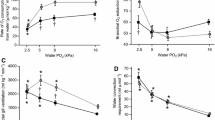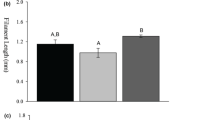Abstract
Lacking a propensity to emerge over the mud surface, the eel goby, Odontamblyopus lacepedii, survives low tide periods by continuously breathing air in burrows filled with hypoxic water. As with most marine air-breathing fishes, O. lacepedii does not possess an accessory air-breathing organ, but holds air in the buccal–opercular cavity. The present study aimed to clarify how the respiratory vasculature has been modified in this facultative air-breathing fish. Results showed that the gills apparently lacked structural modifications for air breathing, whereas the inner epithelia of the opercula were richly vascularized. Comparison with two sympatric gobies revealed that the density of blood capillaries within 10μm from the inner opercular epithelial surface in O. lacepedii (14.5 ± 3.0 capillaries mm−1; mean ± s.d., n = 3) was significantly higher than in the aquatic non-air-breathing Acanthogobius hasta (0.0 ± 0.0) but significantly lower than in the amphibious air-breathing mudskipper, Periophthalmus modestus (59.1 ± 8.5). The opercular capillary bed was supplied predominantly by the 1st efferent branchial arteries (EBA1) and drained by the opercular veins, which open into the anterior cardinal vein. Deep invaginations at the distal end of the EBA1 and the junction with EBA2 are suggestive of blood flow regulatory sites during breath-holding and apnoeic periods. It remains to be investigated how blood flow through the gills is maintained during breath holding when the buccal–opercular cavity is filled with air.







Similar content being viewed by others
Abbreviations
- ABA1-4:
-
1st to 4th afferent branchial arteries
- ACV:
-
anterior cardinal vein
- AFA:
-
afferent filamental artery
- ALA:
-
afferent lamellar arteriole
- BV:
-
blood vessel
- CA:
-
cerebral artery
- CMA:
-
coeliacomesenteric artery
- CnA:
-
connecting artery between EBA1 and EBA2
- DA:
-
dorsal aorta
- DC:
-
ductus Cuvier
- EBA1-4:
-
1st to 4th efferent branchial arteries
- EFA:
-
efferent filamental artery
- ELA:
-
efferent lamellar arteriole
- H:
-
heart
- HV:
-
hepatic vein
- IMC:
-
inner marginal channel of the lamella
- L:
-
lamella
- LA:
-
lateral aorta
- LiA:
-
lingual artery
- MnA:
-
mandibular artery
- MxA:
-
maxillary artery
- OMC:
-
outer marginal channel of the lamella
- ONA:
-
orbitonasal artery
- ONV:
-
orbitonasal vein
- Op:
-
operculum
- OpA1 :
-
opercular artery from the anterior end of EBA1
- OpA2 :
-
opercular artery from the distal end of EBA1
- OpV:
-
opercular vein
- PC:
-
pillar cell
- PCV:
-
posterior cardinal vein
- ScA:
-
subclavian (=pectoral) artery
- VA:
-
ventral aorta
References
Boutilier RG (1990) Control and co-ordination of gas exchange in bimodal breathers. In: Boutilier RG (ed) Advances in comparative and environmental physiology. vol 6. Springer-Verlag, Berlin, pp 279–345
Carter GS (1935) Respiratory adaptations of the fishes of the forest waters, with descriptions of the accessory respiratory organs of Electrophorus electricus (Linn.) (=Gymnotus electricus auctt.) and Plecostomus plecostomus (Linn.). Zool J Linn Soc – Lond 39:219–233
Colombini I, Berti R, Ercolini A, Nocita A, Chelazzi L (1995) Environmental factors influencing the zonation and activity patterns of a population of Periophthalmus sobrinus Eggert in a Kenyan mangrove. J Exp Mar Biol Ecol 190:135–149
Evans DH, Piermarini PM, Choe KP (2005) The multifunctional fish gill: dominant site of gas exchange, osmoregulation, acid–base regulation, and excretion of nitrogenous waste. Physiol Rev 85:97–177
Farmer CG (1999) Evolution of the vertebrate cardio-pulmonary system. Annu Rev Physiol 61:573–592
Gonzales TT, Katoh M, Ishimatsu A (2006) Air breathing of aquatic burrow-dwelling eel goby, Odontamblyopus lacepedii (Gobiidae: Amblyopinae). J Exp Biol 209:1085–1092
Graham JB (1997) Air-breathing fishes: evolution, diversity and adaptation. Academic Press, San Diego, p 299
Graham JB (2006) Aquatic and aerial respiration. In: Evans DH, Claiborne JB (eds) The physiology of fishes. 3rd. edn. CRC Press, Boca Raton, pp 85–117
Graham JB, Lai NC, Chiller D, Roberts JL (1995) The transition to air breathing in fishes. V. Comparative aspects of cardiorespiratory regulation in Synbranchus marmoratus and Monopterus albus (Synbranchidae). J Exp Biol 198:1455–1467
Ikebe Y, Oishi T (1996) Correlation between environmental parameters and behaviour during high tides in Periophthalmus modestus. J Fish Biol 49:139–147
Ishimatsu A, Itazawa Y (1983) Difference in blood oxygen levels in the outflow vessels of the heart of an air-breathing fish, Channa argus: do separate blood streams exist in a teleostean heart? J Comp Physiol 149B:435–440
Laurent P (1984) Gill internal morphology. In: Hoar WS, Randall DJ (eds) Fish physiology. vol 10A. Academic Press, New York, pp 73–183
Liem KF (1980) Air ventilation in advanced teleosts: biomechanical and evolutionary aspects. In: Ali MA (ed) Environmental physiology of fishes. Plenum Press, New York, pp 57–91
Liem KF (1987) Functional design of the air ventilation apparatus and overland excursions by teleosts. Fieldiana Zool New Ser 37:1–29
Low WP, Lane DJW, Ip YK (1988) A comparative study of terrestrial adaptations of the gills in three mudskippers – Periophthalmus chrysospilos, Boleophthalmus boddaerti, and Periophthalmodon schlosseri. Biol Bull 175:434–438
Maina JN (2000) Comparative respiratory morphology: themes and principles in the design and construction of the gas exchangers. Anat Rec (the New Anat) 261:25–44
Martin KLM, Bridges CR (1999) Respiration in water and air. In: Horn MH, Martin KLM, Chotkowski MA (eds) Intertidal fishes: life in two worlds. Academic Press, San Diego, pp 54–78
Munshi JSD (1976) Gross and fine structure of the respiratory organs of air-breathing fishes. In: Hughes GM (ed) Respiration of amphibious vertebrates. Academic Press, London, pp 73–104
Nilsson GE (2007) Gill remodeling in fish – a new fashion or an ancient secret? J Exp Biol 210:2403–2409
Olson KR (2002) Vascular anatomy of the fish gill. J Exp Zool 293:214–231
Park JY (2002) Structure of the skin of an air-breathing mudskipper, Periophthalmus magnuspinnatus. J Fish Biol 60:1543–1550
Randall DJ, Burggren WW, Farrell AP, Haswell MS (1981) The evolution of air breathing in vertebrates. Cambridge University Press, Cambridge, p 133
Sayer MDJ (2005) Adaptations of amphibious fish for surviving life out of water. Fish Fish 6:186–211
Schöttle E (1931) Morphologie und Physiologie der Atmung bei wasser-, schlamm- und landlebenden Gobiiformes. Z Wiss Zool 140:1–114
Takita T, Komura D, Kawahara I, Mori Y, Nakashima N, Ito S (2003) Distribution of fishes in the innermost area of Ariake Sound (in Japanese with English abstract). Bull Saga Pref Ariake Fish Res Dev Center 21:81–98
Tamura O, Moriyama T (1976) On the morphological feature of the gill of amphibious and air breathing fishes. Bull Fac Fish Nagasaki Univ 41:1–8
Weibel ER (2000) Symmorphosis: on form and function in shaping life. Harvard University Press, Cambridge, p 263
Acknowledgements
We are grateful to the Nagasaki Prefectural Institute of Fisheries for the kind permission to use its SEM during the preliminary stages of gill observations. Mr. Shouichi Inaba is thanked for field assistance. TTG was supported by a full scholarship grant from the Ministry of Education, Culture, Sports, Science and Technology (Monbukagakusho) of Japan.
Author information
Authors and Affiliations
Corresponding author
Rights and permissions
About this article
Cite this article
Gonzales, T.T., Katoh, M. & Ishimatsu, A. Respiratory vasculatures of the intertidal air-breathing eel goby, Odontamblyopus lacepedii (Gobiidae: Amblyopinae). Environ Biol Fish 82, 341–351 (2008). https://doi.org/10.1007/s10641-007-9295-5
Received:
Accepted:
Published:
Issue Date:
DOI: https://doi.org/10.1007/s10641-007-9295-5




